|
|
|
Sort Order |
|
|
|
Items / Page
|
|
|
|
|
|
|
| Srl | Item |
| 1 |
ID:
114576
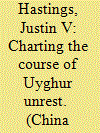

|
|
|
|
|
| Publication |
2012.
|
| Summary/Abstract |
What explains the course of Uyghur-related violence in Xinjiang and Central Asia since 1990? Using data derived from a variety of sources, I argue that the locations and types of violent incidents were influenced by a combination of Chinese government policies and the political geography of Xinjiang. Specifically, 1990 to 1996 were dominated by logistically complex incidents in a low-level violent campaign in Xinjiang. The Strike Hard campaign in 1996 brought about an increase in logistically simple incidents in Xinjiang and some violence in Central Asia as Uyghur separatists had trouble moving people, information and weapons across the well-guarded, difficult terrain of Xinjiang's borders. China's rapprochement with Central Asian countries in the late 1990s led after 2001 to a dramatic decrease in Uyghur-related violence in general, but also signalled the appearance of logistically creative attacks that required little planning or materials. My findings suggest that Uyghur rebels will have a difficult time mounting a large-scale violent campaign as long as China retains even minimal control of Xinjiang.
|
|
|
|
|
|
|
|
|
|
|
|
|
|
|
|
| 2 |
ID:
153680
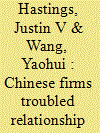

|
|
|
|
|
| Summary/Abstract |
The coping strategies that small Chinese firms operating in North Korea have chosen involve insinuating themselves into North Korean political and social networks, and structuring their investments so as to minimize their exposure to North Korean infrastructure, workers, and institutions. As a result, it is unlikely that Chinese firms will be the main drivers of market transformation in North Korea.
|
|
|
|
|
|
|
|
|
|
|
|
|
|
|
|
| 3 |
ID:
175051
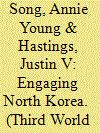

|
|
|
|
|
| Summary/Abstract |
Despite ongoing political tensions and sanctions, North Korea and South Korea have made some progress in forestry cooperation. To explain the persistence of this cooperation, we draw upon a local approach to environmental peacebuilding. By tracing inter-Korean forestry cooperation from 2000 to 2018, this study finds that cooperation persists because of a North Korean desire for cooperation specifically on the environment, and because non-governmental organisations (NGOs) with close ties to the South Korean government provided an alternative way to implement inter-Korean forestry cooperation through periods of tension. Our findings also highlight the benefits of using environmental cooperation as a way to engage with North Korea in a depoliticised and sanction-free context. This finding has far-reaching implications for environmental peacebuilding. First, NGOs can pave the way for engaging conflict parties even in the face of ongoing hostility. Second, environmental cooperation provides an opportunity for a win–win strategy for conflict parties.
|
|
|
|
|
|
|
|
|
|
|
|
|
|
|
|
| 4 |
ID:
115300
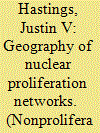

|
|
|
|
|
| Publication |
2012.
|
| Summary/Abstract |
This article uses a geographic approach to examine one aspect of the nuclear black market: the coordinators who bring buyers and sellers together, and transport goods between them. The most important factor in determining the geographical structure of a proliferation network is the network coordinator's access (or lack thereof) to unique state resources. Coordinators with access to state resources and prerogatives can avoid embedding themselves in hostile countries or relying on commercial infrastructure, often leading to territorially diffuse logistical networks. Coordinators without such access are forced to rely on commercial infrastructure and favorable local political, economic, and social conditions, often resulting in territorially centralized logistical networks. This is illustrated through case studies of Abdul Qadeer Khan's supply networks to Pakistan, Libya, and Iran. The article concludes with some observations about the implications of a geographical approach for understanding nuclear proliferation networks.
|
|
|
|
|
|
|
|
|
|
|
|
|
|
|
|
| 5 |
ID:
084570
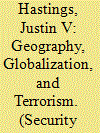

|
|
|
|
|
| Publication |
2008.
|
| Summary/Abstract |
How do ordinary people come to commit genocide against their neighbors? Ethnicity-based approaches cannot explain the different pathways that lead to mass violence or the different forms that participation takes over time and place. In Rwanda, different processes and mechanisms led some to join in the carnage while others resisted. Utilizing Mark Granovetter's concept of “social embeddedness,” this article argues that social ties and immediate social context better explain the processes through which ordinary people came to commit mass murder in Rwanda. Leaders used family ties to target male relatives for recruitment into the killing groups, which were responsible for carrying out the genocide. Ties among members of the killing groups helped to initiate reluctant or hesitant members into committing violence with the group. Finally, ties of friendship attenuated murderous actions, leading killers to help save Tutsi in specific contexts. Which ties became salient depended on the context. In the presence of the killing group or authority(ies), low-level participants (a group I call “Joiners”) tended to go along with the violence. Alone, Joiners often made different choices. The findings in this article are based on data collected during nine months of fieldwork in two rural communities and two central prisons in Rwanda.
|
|
|
|
|
|
|
|
|
|
|
|
|
|
|
|
| 6 |
ID:
092516
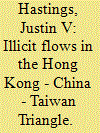

|
|
|
| 7 |
ID:
160632
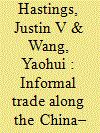

|
|
|
|
|
| Summary/Abstract |
Why do Chinese traders along the China–North Korea border turn to informal trade, and what does it provide for them? Using a unique set of interviews with Chinese formal and informal traders operating in North Korea, we argue that the strategies of informal trade are a calculated response to certain types of risk. In doing so, we introduce a typology of risks and the mechanisms by which informal trade allows traders to mitigate those risks. Because informal traders bypass trade regulations and border checkpoints, they are able to mitigate risk more cheaply than formal traders in some cases and can overcome barriers that can cause failure in formal trade. Informal traders can thus maintain trade in many circumstances, including across North Korean personnel instability and policy reversals, Chinese sanctions enforcement, and delays and smuggling crackdowns on both sides of the border.
|
|
|
|
|
|
|
|
|
|
|
|
|
|
|
|
| 8 |
ID:
188069


|
|
|
|
|
| Summary/Abstract |
Why do some insurgent organizations launch maritime attacks? To examine why organizations would engage in this behavior we draw on a new dataset of insurgencies to investigate the organizational characteristics associated with maritime attacks. We find that there are two types of maritime attacks by insurgencies. While both types of attacks are associated with the trappings of a state, beyond those factors, maritime revenue-raising attacks take place in a milieu of criminal activity, while maritime non-revenue-raising attacks are associated with an insurgency’s organizational sophistication and capacity.
|
|
|
|
|
|
|
|
|
|
|
|
|
|
|
|
| 9 |
ID:
141478
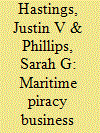

|
|
|
|
|
| Summary/Abstract |
The two regions with the greatest incidence of maritime piracy in Africa, the Horn of Africa and the Gulf of Guinea, are also known for the low quality of the institutions underlying their political economies. This article investigates how institutions in these areas shape and constrain the sophisticated maritime piracy syndicates and their behaviour. Engaging with the literature on state failure and maritime piracy, we argue that norms and institutions constrain even criminal organizations like piracy groups, which often mimic and are embedded in the licit economy. In the Horn of Africa, pirates take structural and ideational cues from the licit economy and are constrained by the informal regulations that govern clan groups, rent-based economic activities, and collective security arrangements in Somalia. In West Africa, sophisticated piracy both preys upon and arises from the formal economy, specifically the international oil industry. As a result, piracy networks often mirror and draw from both the formal institutions in Nigeria used to regulate and protect oil production, and those engaged in oil production, processing, distribution, and transportation.
|
|
|
|
|
|
|
|
|
|
|
|
|
|
|
|
| 10 |
ID:
158477
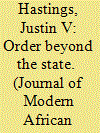

|
|
|
|
|
| Summary/Abstract |
How do some places with weak institutional capacity avoid being caught in the cycles of violence and criminality so often associated with African institutions in the ‘failed states’ literature? This paper exploits in-country variation in piracy incidence across different regions of Somalia to investigate how some territories with low state capacity can nonetheless deter piracy and provide relative order. We find that the usual explanation – state ‘failure’ in Somalia, compared with a reasonably functional government in Somaliland – does not withstand scrutiny. Somaliland's lack of piracy was not due to ‘strong’ state institutions, but can be attributed to the strength of a discourse that emphasises Somaliland's ‘inherent’ capacity for order against the disorder supposedly endemic to the rest of Somalia. The exploration of the discursive underpinnings of Somaliland's supposed ‘piratelessness’ has implications for understanding the relationship between state institutions, political order and violence, particularly where the state does not exercise a monopoly on force.
|
|
|
|
|
|
|
|
|
|
|
|
|
|
|
|
| 11 |
ID:
170994
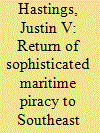

|
|
|
|
|
| Summary/Abstract |
What explains the recent (perhaps temporary) resurgence of sophisticated maritime pirate attacks in Southeast Asia in the face of strong regional counter-piracy efforts? Given Southeast Asian countries' relatively well-functioning institutions, political, economic, and conflict-related explanations for the return of piracy are incomplete. As an innovative extension to structural arguments on piracy incidence, we take an approach that focuses on adaptation by the pirates themselves, using incident-level data derived from the International Maritime Organization to track how sophisticated pirate organizations have changed what, where, and how they attack. In response to counter-piracy efforts that are designed to deny pirates the political space, time, and access to economic infrastructure they need to bring their operations to a profitable conclusion, pirates have adapted their attacks to minimize dependence on those factors. Within Southeast Asia, this adaptation varies by the type of pirate attack: ship and cargo seizures have shifted to attacks that move quickly, ignore the ship, and strip only cargo that can be sold profitably, while kidnappings involve taking hostages off ships to land bases in the small areas dominated by insurgent groups. The result is a concentration of ship and cargo seizures in western archipelagic Southeast Asia, and a concentration of kidnappings in areas near Abu Sayyaf Group strongholds.
|
|
|
|
|
|
|
|
|
|
|
|
|
|
|
|
| 12 |
ID:
167795
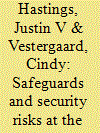

|
|
|
|
|
| Summary/Abstract |
Historically, there have been limited international controls at the very front end of the nuclear fuel cycle, which consists of mining, processing, transportation, and conversion of natural uranium. However, an evolving framework of nuclear-security treaties along with International Atomic Energy Agency clarifications of the materials subject to its safeguards obligations are increasing the coverage of source materials, raising the question of how new and traditional uranium suppliers should handle safeguards and security in the production of uranium. We use a risk framework to assess the likelihood and consequences of different proliferation risks. Although the consequences for proliferation are generally low, risks to the very front end are different for safeguards (state diversion) and nuclear-materials security (unauthorized removal by non-state actors). For safeguards risks, cases of diversion or undeclared activities are concentrated at conversion facilities, while theft or trafficking of front-end material represents a relatively small percentage of total security incidents, concentrated in countries with lower levels of nuclear-materials security. We conclude that safeguards and security obligations should be commensurate with the risks. An appropriate response should involve a risk-based, graduated approach to nuclear security and a flexible, more clearly framed approach to safeguards.
|
|
|
|
|
|
|
|
|
|
|
|
|
|
|
|
| 13 |
ID:
125130


|
|
|
|
|
| Publication |
2013.
|
| Summary/Abstract |
In this article, we examine the relationship between hardening a target and the value that a terrorist group derives from attacking it. We use a simple expected value framework to compare how the expected value of attacking a hardened target varies between a violence-based approach, where terrorists are presumed to be maximizing the physical damage done to the target, and a signaling-based approach, where terrorists are presumed to be maximizing the symbolic value of their attack. We argue that, if it is proper to understand terrorist attacks as costly signals of terrorist strength or determination, hardening a target actually increases the expected value of attacking a target (relative to its value before hardening), even if the attack fails. We go on to examine the evolution of aviation security, and trace how al-Qaeda's views of airplanes and airports as targets have changed since 9/11. As aviation targets were hardened with increasingly onerous security measures, al-Qaeda began to see even attacks that did not result in detonation as successes, in large part because of what they signaled about al-Qaeda's abilities, and the ability of al-Qaeda to impose costs on the U.S. and other countries even in the absence of explosions.
|
|
|
|
|
|
|
|
|
|
|
|
|
|
|
|
| 14 |
ID:
155491


|
|
|
|
|
| Summary/Abstract |
Transnational crime brings substantial foreign capital into a number of fragile and developing states. Yet the economic and political impacts of such capital have rarely been studied, due to the challenges of obtaining accurate data on illicit activities. We overcome this challenge by compiling a dataset on the amount and disbursement dates of ransom payments made by ship owners and insurers to Somali pirates from 2005 to 2012, along with sub-national commodity prices and trade flows in Somalia. Using a difference-in-differences strategy, we find that ransoms have effects similar to those associated with the Dutch Disease. These effects include appreciating the local currency, decreasing export competitiveness, and increasing import dependence. Our results illuminate a new and distinct channel through which illicit capital can undermine long-term economic development and foster an economic and political dependency on illicit sectors.
|
|
|
|
|
|
|
|
|
|
|
|
|
|
|
|
| 15 |
ID:
153316
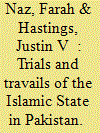

|
|
|
|
|
| Summary/Abstract |
While Pakistan is in many ways an ideal location for transnational terrorist groups due to state weakness, Islamic State has had difficulty making headway in the country. In this article, the authors argue that Islamic State’s failures in Pakistan are due to competition from other groups. Drawing on the terrorist competition literature and interviews with Pakistani counterterrorism officials, the authors find that the presence of other groups in Pakistan meant there was little demand for what Islamic State offered. Islamic State relied on splinter groups and defectors for recruitment, which alienated mainstream groups and harmed the group’s capacity. Islamic State’s competition problems were exacerbated by its internationalist ideology, which was at odds with that of many groups in Pakistan, and allowed opposing groups to present themselves as reasonable alternatives to other actors. Despite Islamic State’s lack of success, it and its allies have still engaged in extreme violence in Pakistan as a result of attempts to outbid other groups. This article has implications for fighting terrorism in Pakistan and more generally.
|
|
|
|
|
|
|
|
|
|
|
|
|
|
|
|
| 16 |
ID:
116243
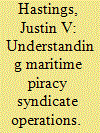

|
|
|
|
|
| Publication |
2012.
|
| Summary/Abstract |
In this article, I explain maritime piracy syndicates' structure and behavior as based on two required inputs: the time needed between an attack and the realization of profit, and access to certain economic and security goods, namely a secure environment and market infrastructure. Pirates face two challenges. Internally, they must keep the organization together during the operation, a challenge I examine with a principal-agent framework to show how the inputs shape the security and control tradeoffs that exist, or not. Externally, pirates must maintain access to the external resources necessary for the success of their operation. I then turn to the adaptations in internal structure, targeting, and network connections that different types of pirate syndicates make to resolve principal-agent problems and external resource access problems during operations.
|
|
|
|
|
|
|
|
|
|
|
|
|
|
|
|
| 17 |
ID:
188329
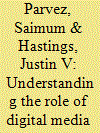

|
|
|
|
|
| Summary/Abstract |
Notwithstanding the discernable participation of women in terrorist groups, empirical research on women in terrorism is very scant in Bangladesh. To fill this gap, our article examines women’s involvement in terrorism by analyzing the life stories of dozens of Bangladeshi women terrorists. We use a terrorist lifecycle approach to understand the role of digital media in female participation, particularly in terms of when in the lifecycle digital media becomes important, and in terms of how digital media interacts with other factors to shape women’s involvement in terrorist organizations. After analyzing female profiles and their socio-demographic traits, we provide an in-depth analysis of three female terrorist lifecycles. An analysis of the profiles of Bangladeshi terrorists who use digital media reveals that women were more likely to use digital media than men in the recruitment phase. The in-depth case studies of three female terrorist profiles find that multiple and different factors impact their terrorist life cycles. Social networks – families and friends – typically play a role in individuals’ decision to become involved and further engagement in terrorism. Specifically, digital media allows women to expand their social interactions beyond what is possible in person, thus allowing for virtual pathways into terrorism.
|
|
|
|
|
|
|
|
|
|
|
|
|
|
|
|
| 18 |
ID:
140870


|
|
|
|
|
| Summary/Abstract |
Terrorist groups are often relatively conservative in their choice of strategy, tactics, and targets, and it is worth asking what characteristics are associated with unconventional behavior. In this article we explore the question of why terrorist organizations move to one type of unconventional attack that has been a focus of concern of policymakers in recent years, namely attacks on maritime targets. Through an investigation of the organizational capacity and ideology of terrorist groups that committed maritime attacks between 1998 and 2005, we argue that this kind of violent behavior is driven by capability. Certain organizational characteristics of terrorist groups—territorial control, involvement in the drug trade, organizational size, and connections with other groups—provide groups with the capabilities that make maritime attacks both realistic and desirable. Terrorist groups' ideology—what they believe, and what their goals are—does not have the same impact, with the possible exception of groups affiliated with al-Qaeda. Our findings have implications for future research.
|
|
|
|
|
|
|
|
|
|
|
|
|
|
|
|
|
|
|
|
|